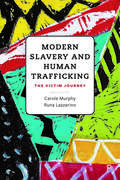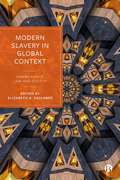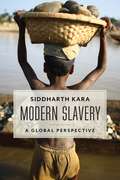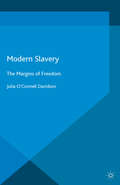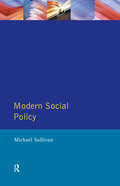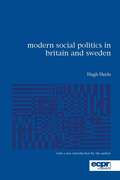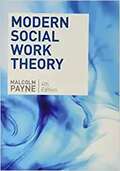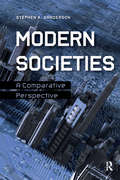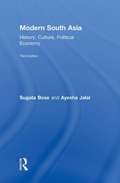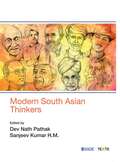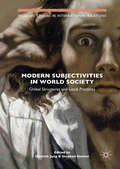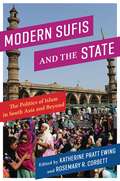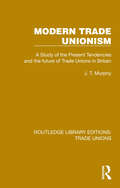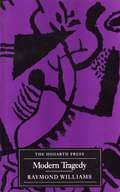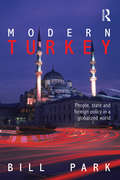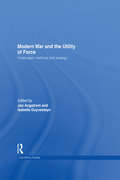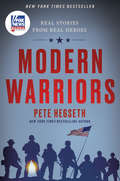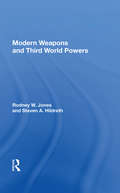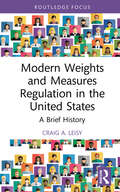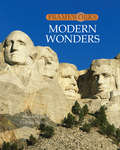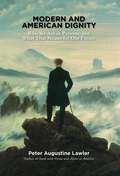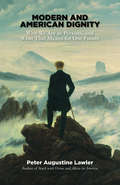- Table View
- List View
Modern Slavery and Human Trafficking: The Victim Journey
by Carole Murphy and Runa LazzarinoWith a foreword by Patricia HynesThroughout the world, vulnerable people are being deceived into entering abusive journeys. Whether in the organ trade, exploitative labour businesses or forced criminality, their lives will never be the same. This book traces the journey of victims/survivors of modern slavery and human trafficking into and within the UK, from recruitment to representation to (re)integration. Using global comparative case studies, it discusses recruitment tactics and demand, prevention in supply chains, issues with effective legal protection and care services and vulnerability to re-trafficking. It also examines the ideological misrepresentation of vulnerable migrants and victims/survivors in media, the film industry, legislation and more. Rooted in diverse practitioner experience, disciplines and empirical research, this book bridges the experience-research-practice-policy gap by bringing to the fore survivors’ voices. In doing so, it offers crucial suggestions for better public awareness, policies and practices that will impact interventions in the UK and beyond.
Modern Slavery in Global Context: Human Rights, Law, and Society
by Elizabeth A. FaulknerThis thought-provoking collection brings together academics from a range of disciplines to examine modern slavery. It illustrates how different disciplinary positions, methodologies and perspectives form and clash together through a kaleidoscopic view to contribute a unique insight into critical modern slavery studies. Providing a platform to critique the legal, ideological and political responses to the issue, experts interrogate the construct of modern slavery and the anti-trafficking discourse which have dominated contemporary responses to and understandings of exploitation. Drawing on a range of global real-world examples, this is a vital contribution to the study of modern slavery.
Modern Slavery: A Global Perspective
by Siddharth KaraSiddharth Kara is a tireless chronicler of the human cost of slavery around the world. He has documented the dark realities of modern slavery in order to reveal the degrading and dehumanizing systems that strip people of their dignity for the sake of profit—and to link the suffering of the enslaved to the day-to-day lives of consumers in the West. In Modern Slavery, Kara draws on his many years of expertise to demonstrate the astonishing scope of slavery and offer a concrete path toward its abolition.From labor trafficking in the U.S. agricultural sector to sex trafficking in Nigeria to debt bondage in the Southeast Asian construction sector to forced labor in the Thai seafood industry, Kara depicts the myriad faces and forms of slavery, providing a comprehensive grounding in the realities of modern-day servitude. Drawing on sixteen years of field research in more than fifty countries around the globe—including revelatory interviews with both the enslaved and their oppressors—Kara sets out the key manifestations of modern slavery and how it is embedded in global supply chains. Slavery offers immense profits at minimal risk through the exploitation of vulnerable subclasses whose brutalization is tacitly accepted by the current global economic order. Kara has developed a business and economic analysis of slavery based on metrics and data that attest to the enormous scale and functioning of these systems of exploitation. Beyond this data-driven approach, Modern Slavery unflinchingly portrays the torments endured by the powerless. This searing exposé documents one of humanity’s greatest wrongs and lays out the framework for a comprehensive plan to eradicate it.
Modern Slavery: The Margins of Freedom
by Julia O'Connell DavidsonProviding a unique critical perspective to debates on slavery, this book brings the literature on transatlantic slavery into dialogue with research on informal sector labour, child labour, migration, debt, prisoners, and sex work in the contemporary world in order to challenge popular and policy discourse on modern slavery.
Modern Social Policy: Modern Social Policy In Western Society (Harvester Wheatsheaf Studies In Sociology Ser.)
by Michael SullivanFirst published in 1994. Routledge is an imprint of Taylor & Francis, an informa company.
Modern Social Politics in Britain and Sweden: From Relief To Income Maintenance (ECPR Classics)
by Hugh HecloModern Social Politics in Britain and Sweden was the winner of the 1974 Woodrow Wilson Foundation Book Award for the best book published in the United States on government, politics, or international affairs.
Modern Social Work Theory
by Malcolm PayneThis masterly text is a classic in its field and will be a reliable companion throughout the course of your studies and your career as a social work practitioner. In this substantially reworked and updated fourth edition of his best-selling text, Malcolm Payne presents clear and concise evaluations of the pros and cons of major theories that inform social work practice, and comparisons between them. <p><p> Modern Social Work Theory is now more accessible and comprehensive than ever, offering: the most complete coverage of social work theory, from classic perspectives to the very latest ideas, including a new chapter dedicated to strengths, narrative, and solutions approaches; a host of brand new case examples showing how theories can be applied to everyday practice; new analysis of the ethical dimensions of different social work theories and what common values they share; Pause and Reflect questions to encourage you to draw on your own experience and develop your thinking; and updated Example text sections which summarize the most current thinking and help bridge the gap between introductions to each theory and more specialist writing.
Modern Societies: A Comparative Perspective
by Stephen K. SandersonFirst Published in 2016. Routledge is an imprint of Taylor & Francis, an Informa company.
Modern South Asia: History, Culture, Political Economy
by Ayesha Jalal Sugata Bose<P>Drawing on the newest and most sophisticated historical research and scholarship in the field, Modern South Asia provides a challenging insight for those with an intellectual curiosity about the region.<P> After sketching the pre-modern history of the subcontinent, the book concentrates on the last three centuries.<P> Jointly authored by two leading Indian and Pakistani historians, it offers a rare depth of historical understanding of the politics, cultures, and economies that shape the lives of more than a fifth of humanity.
Modern South Asian Thinkers
by Dev Nath Pathak Sanjeev Kumar H. M.An accessible compendium that puts together the political, social, literary and humanist perspectives of modern thinkers of South Asia. This book is a rare collection of essays on contemporary South Asian thinkers and their ideas. It seeks to introduce readers to the lives and beliefs of these thinkers who come from diverse disciplinary backgrounds such as Political Science, Sociology, Anthropology, Economics and Humanities. The book discusses the works of 61 thinkers from across the region, avoiding both disciplinary and cartographic boundaries. One of the unique features of this text is that it moves away from the confines of traditional Eurocentric understanding of South Asia. Modern South Asian Thinkers will help readers understand the intellectual density of the region in a concise yet engaging manner. Key Features: Presents thinkers from various backgrounds, disciplines and nations. Each essay relates thinkers with their location and contemporary surroundings. Includes selections with sensitivity to nations and narrations. Each entry is aided by boxed material on trivia, famous quotes and key inferences.
Modern Subjectivities in World Society: Global Structures and Local Practices (Palgrave Studies in International Relations)
by Stephan Stetter Dietrich JungThis book brings together theories of world society with poststructuralist and postcolonial work on modern subjectivity to understand the universalising and particularising processes of globalisation. It addresses a theoretical void in global studies by attending to the co-constituted process through which modern subjectivities and global processes emerge and interact. The editors outline a key problem in global studies, which is a lack of engagement between the local/particular/individual and the ‘universalising’ processes in which they are situated. The volume deals with this concern with contributions from historical sociologists, poststructuralist and postcolonial scholars and by focusing in the Middle East, religion in global modernity and non-human subjectivities.
Modern Sufis and the State: The Politics of Islam in South Asia and Beyond (Religion, Culture, and Public Life)
by Katherine Pratt Ewing and Rosemary R. CorbettSufism is typically thought of as the mystical side of Islam. In recent years, it has been held up as a supposedly peaceful alternative to the spread of forms of Islam associated with violence, an embodiment of democratic ideals of tolerance and pluralism. Are Sufis in fact as otherworldy and apolitical as this stereotype suggests?Modern Sufis and the State brings together a range of scholars, including anthropologists, historians, and religious-studies specialists, to challenge common assumptions that are made about Sufism today. Focusing on India and Pakistan within a broader global context, this book provides locally grounded accounts of how Sufis in South Asia have engaged in politics from the colonial period to the present. Contributors foreground the effects and unintended consequences of efforts to link Sufism with the spread of democracy and consider what roles scholars and governments have played in the making of twenty-first-century Sufism. They critique the belief that Salafism and Sufism are antithetical, offering nuanced analyses of the diversity, multivalence, and local embeddedness of Sufi political engagements and self-representations in Pakistan and India. Essays question the portrayal of Sufi shrines as sites of toleration, peace, and harmony, exploring cases of tension and conflict. A wide-ranging interdisciplinary collection, Modern Sufis and the State is a timely call to think critically about the role of public discourse in shaping perceptions of Sufism.
Modern Trade Unionism (Routledge Library Editions: Trade Unions #15)
by J. T. MurphyOriginally published in 1935, this provocative book examined the tendencies of the Trade Unions in early 20th Century Britain in the light of their history. An advocate of a Socialist society, the author regarded the form and limited functions of the trade unions as temporary and predicted that they would be transformed into industrial unions and become part of the administrative mechanism of industry which would endure.
Modern Tragedy
by Raymond WilliamsIn Modern Tragedy, Williams bridges the gap between literary and socio-economic study, tracing the notion of tragedy from its philosophical and dramatic origins with Aristotle. In addition, Williams discusses tragedy in Chaucher, Nietzche, Brecht, Sartre and other leading figures in the history of thought, as well as elements of tragic experience – both political and personal - in socialist revolutions of the 20th century.
Modern Treaty Law and Practice
by Anthony AustOn the publication of its first edition, this textbook was welcomed as the definitive study of treaty law written from the viewpoint of an experienced practitioner. As with the first, this edition aims to provide the student and practitioner with a full understanding of the law and updates existing information and refines previous arguments. New to its scope of examination is the study of the use of memorandums of understanding (MOUs) in litigation, the treaty-making capacity of entities such as the Vatican, Taiwan and Palestine, and the effect of hostilities on treaties. Given their increasing importance, there is also a new chapter on international organisations, including an attempt to explain the sometimes baffling roles in treaty-making played by the European Community and European Union. Students and practitioners alike will find this an invaluable guide to this increasingly important subject.
Modern Turkey: People, State and Foreign Policy in a Globalised World
by Bill ParkThis exciting new textbook provides a broad and comprehensive overview of contemporary Turkey. Placing the country and its people within the context of a rapidly globalizing world, the book covers a diverse range of themes such as politics, economics, international relations, the Turkic world, religion and recent historical background. Tracing the evolution of Turkey’s domestic political and economic systems, and its foreign policy, from the inception of the republic to the present day, the themes covered include: the impact of globalization on Turkey’s society, politics, economy and foreign policy the role of the EU and the Turkish diaspora in the evolution of Turkish policies the main features and prominent role of Kemalism turkish foreign policy, and the new challenges and opportunities brought by the end of the cold war the position of Turkey as a ‘bridge’ between East and West, and the particular and unique dilemmas confronting a Muslim but economically developed, democratized state allied to the West Kurdish identity the Fethullah Gulen movement and the Armenian ‘genocide’. Situating the country as a ‘model’ for the wider Muslim world, this sophisticated analysis of one of the largest and most important states in the Middle East will be an invaluable resource for scholars and officials interested in Turkish politics and US foreign and security policies, and for students of the Balkan, Middle Eastern, Caucasus and Central Asian regions.
Modern War and Grey Zones: Design for Small States
by David Last Marzena ŻakowskaThis book explores the challenges small states face in navigating the complexities of modern war, particularly within the ambiguous Grey Zones where the boundaries between peace and conflict blur.This book addresses the multifaceted challenges of policy, strategy, operations, and tactics, providing valuable insights into how small states can deter and manage violence. It highlights the vital role of international organizations, alliance‑building, cyber operations, information warfare, lawfare, and the balance of power. Additionally, it tackles the issue of strengthening state security and fostering social cohesion in the face of Grey Zone threats. A distinctive feature of this book is the inclusion of innovative design problems developed to assist small states in navigating complex security landscapes with both practical and strategic approaches.This book will be essential reading for security practitioners and military professionals and of great interest to students of security studies, defense studies, and international relations.
Modern War and the Utility of Force: Challenges, Methods and Strategy (Cass Military Studies)
by Isabelle Duyvesteyn Jan AngstromThis book investigates the use and utility of military force in modern war. After the Cold War, Western armed forces have increasingly been called upon to intervene in internal conflicts in the former Third World. These forces have been called upon to carry out missions that they traditionally have not been trained and equipped for, in environments that they often have not been prepared for. A number of these 'new' types of operations in allegedly 'new' wars stand out, such as peace enforcement, state-building, counter-insurgency, humanitarian aid, and not the least counter-terrorism. The success rate of these missions has, however, been mixed, providing fuel for an increasingly loud debate on the utility of force in modern war. This edited volume poses as its central question: what is in fact the utility of force? Is force useful for anything other than a complete conventional defeat of a regular opponent, who is confronted in the open field? This book will be of much interest to students of strategic studies, war and conflict studies, counter-insurgency, security studies and IR. Isabelle Duyvesteyn is an Associate Professor at the Department of History of International Relations, Utrecht University in the Netherlands. Jan Angstrom is a researcher at the Swedish National Defence College.
Modern Warriors: Real Stories from Real Heroes
by Pete HegsethA New York Times bestseller.From FOX & Friends Weekend cohost Pete Hegseth comes a collection of inspiring stories from fifteen of America’s greatest heroes—highly decorated Navy SEALs, Army Rangers, marines, Purple Heart recipients, combat pilots, a Medal of Honor recipient, and more—based on FOX Nation’s hit show of the same name.After three Army deployments—earning two Bronze Stars and a Combat Infantryman’s Badge—Pete Hegseth knows what it takes to be a modern warrior. In Modern Warriors he presents candid, unfiltered conversations with fellow modern warriors and digs for real answers to key questions like: What inspired them to serve? What is their legacy? What does sacrifice really mean to them? How do they handle loss? And what can civilians learn from this latest generation of veterans?From the skies over Afghanistan to the seas of the Mediterranean to the treacherous streets of Iraq, these brave men and women take you inside the firefight, sharing the harrowing realities of war. Hegseth uses their experiences to facilitate conversations about the raw truths of combat, including the difficulties of transitioning back home, while also celebrating these soldiers’ contributions to preserving our nation’s most precious gift—freedom.In addition to the oral history, Modern Warriors presents dozens of personal, rarely shared photos from the battlefield and the home front. Together these stories and images provide an unvarnished representation of battlefield leadership, military morale, and the strain of war. This book is the perfect keepsake and gift for anyone who wants to know what it means, and what it truly takes, to be a patriot.
Modern Weapons And Third World Powers
by Rodney W JonesThe possession of high-technology weapons, some capable of mass destruction, is no longer the exclusive prerogative of superpowers. This volume explores the international and security issues raised by the acquisition of modern weapons among emerging Third World powers and its implications for U.S. policy. Based on the findings of a year-long resear
Modern Weights and Measures Regulation in the United States: A Brief History (Routledge Research in Public Administration and Public Policy)
by Craig A. LeisyIn this book, Craig A. Leisy provides a concise history of weights and measures regulation in the United States from the early 20th century up to the present day. Written for academic and professional readers, Leisy describes basic terms and concepts, the origins and history of weights and measures laws, weights and measures regulation, the economics of regulation, key enforcement cases, landmark legal decisions, the effects of public policy, and a forecast on the future of weights and measures regulation. He also discusses the impact of weights and measures regulation on both producers (sellers) and consumers (buyers) in the marketplace. The book also features a new 2019 survey of state weights and measures regulatory programs, an introduction to the economics of weights and measures regulation, a case study of the municipal weights and measures regulatory program in Seattle, Washington, details of a major gasoline dispenser fraud case in Los Angeles County, and landmark legal cases related to net contents of packaged goods. Modern Weights and Measures Regulation in the United States is the only book on this subject from the perspective of a former long-time weights and measures regulatory official.
Modern Wonders (Frameworks (group 1) Ser.)
by Cynthia Phillips Shana PriwerModern Wonders, a title in the five-title series Frameworks: Science, Technology, and the Built Environment, illuminates the science, technology, art and architecture, and history of the world's greatest architectural and engineering achievements, including the Eiffel Tower, St. Louis Gateway Arch, World Trade Center, Mt. Rushmore, and the Millennium Wheel. Modern Wonders provides an interdisciplinary, visual approach that combines informative text, fascinating background information, and basic scientific principles with dozens of full-color photographs, illustrations, and other visuals (e.g. diagrams and equations). Appropriate for a broad audience of students, teachers, librarians, and general interest readers, Modern Wonders is an excellent supplemental resource for subjects covered throughout the curricula: science, technology, and society; art and architecture; economics; and world history and culture.
Modern World History: Patterns Of Interaction Workbook
by Mcdougal LittleThis valuable resource provides chapter summaries, vocabulary support and reading comprehension questions written for the 9-12 grade level. A two page study guide is included for every section of the textbook.
Modern and American Dignity: Who We Are as Persons, and What That Means for Our Future
by Peter Augustine LawlerA Simon & Schuster eBook. Simon & Schuster has a great book for every reader.
Modern and American Dignity: Who We Are as Persons, and What That Means for Our Future
by Peter LawlerAn Indispensable Guide to Our Most Pressing Moral and Political DebatesThe horrors of the twentieth century exposed the insufficiency of speaking of human rights. In intending to extinguish whole classes of human beings, the Nazis and Communists did something much worse than violating rights; they aimed to reduce us all to less than who we really are. As political philosopher Peter Augustine Lawler shows in this illuminating book, rights are insecure without some deeper notion of human dignity.The threats to human dignity remain potent today--all the more so for being less obvious. Our anxious and aging society has embraced advances in science, technology, and especially biotechnology--from abortion and embryonic stem-cell research to psychopharmacology, cosmetic surgery and neurology, genetic manipulation, and the detachment of sex from reproduction. But such technical advances can come at the expense of our natural and creaturely dignity, of what we display when we know who we are and what we're supposed to do. Our lives will only become more miserably confused if we cannot speak confidently about human dignity.In Modern and American Dignity, Lawler, who served on President George W. Bush's Council on Bioethics, reveals the intellectual and cultural trends that threaten our confidence in human dignity. Exploring a wide range of topics with wit and elegance, Lawler has provided an indispensable guide to today's complex political, bioethical, and cultural debates.
